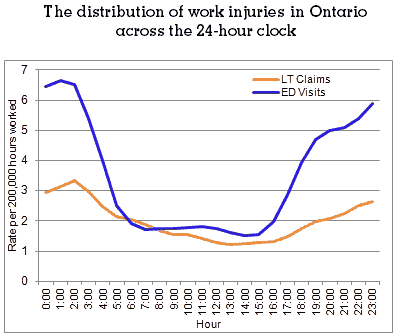Whether you’re a man or woman, young or old, doing manual or non-manual work, you’d be more likely to be injured on the job during the evening, night or early morning hours than during a regular daytime shift.
A recent study from the Institute for Work & Health (IWH)—published in the January 2013 issue of Occupational & Environmental Medicine (vol. 70, no. 1, pp. 49-56; doi 10.1136/oemed-2012-100920)—found that about 12 per cent of work injuries experienced by women and six per cent of work injuries experienced by men were attributed to the higher risk of work injury during evening, night and early morning hours.

This dovetails with the findings of a previous study in which IWH also took part. That study found 14 per cent of work injuries experienced by women, and eight per cent of work injuries experienced by men, were attributed to the higher risk of work injury arising from working nights (see article from Winter 2011 At Work, "Are those who work shifts more at risk of work injury?").
The confirmation of an increased risk of injury during non-traditional work hours is important, says IWH President and Senior Scientist Dr. Cam Mustard, who led the study. But even more important, he says, was the ability to collect information on work injury by time of day for a very large proportion of the Ontario workforce, not just those in a particular workplace or job sector. This type of information has not been readily available in the past.
Given that 25 per cent of the Canadian labour force works outside the standard five-day, nine-to-five work week, being able to measure risk by time of day is crucial, Mustard says. It allows the prevention system to understand how risk fluctuates throughout the day, and also learn how to effectively address the elevated risks of shift work.
The risk of working non-standard hours is relatively invisible, and a risk unrecognized is a risk unmanaged,
he says. Now we can shine a light on the problem and take a closer look at what is really happening and how to address it.
The number of work injuries by time of day among workers aged 15 to 64 in Ontario over the five-year period, from 2004 to 2008, came from two different sources. The first was the Workplace Safety and Insurance Board’s lost-time claims data, which includes information on date and time of injury. The second was the National Ambulatory Care Reporting System, which records all emergency department visits in Ontario. These records indicate whether a person was injured at work, as well as the time of triage.
Novel approach
To determine the total number of hours worked at what time of day in Ontario as a whole, which was needed to calculate rate of injury by time of day, the researchers used two Statistics Canada surveys. The Labour Force Survey let researchers determine total hours worked in the province over the five-year period. The General Social Survey, which periodically uses a diary format to collect information on time use, allowed researchers to distribute these total hours across the 24-hour clock.
Our challenge was not counting injuries by time of day because we could get that information readily from workers’ compensation and emergency department records,
explains Mustard. The hard part was establishing the number of people working at various times of day. Our use of the StatsCan surveys was a novel solution to this challenge.
The study found that the rate of work injury is lower during the daytime hours between 6 a.m. and 4 p.m. The rate of work injury outside of these hours goes up during the evening hours (5 p.m. to midnight) and early morning hours (midnight to 5 a.m.).
Researchers found that the risk of work injury increased during evening and early morning hours for both men and women (although more so for women), and among all age groups (although the risk was higher for workers 35 to 64 compared to those 15 to 34). They also found an increased risk of work injury during non-standard hours for all occupational groups—manual, non-manual or a mix of both (although more so for those in manual and mixed jobs).
This study shows that the increase in work injury during non-standard working hours is not due to the nature of the work, but due to time of day,
says Mustard.
Why is risk higher at night? Mustard points to two possible factors. The first is worker fatigue due to sleep disturbance and/or long work hours. The second is lower levels of supervision and co-worker support during non-daytime hours.
Read the full open-access study at the Occupational and Environmental Medicine website.